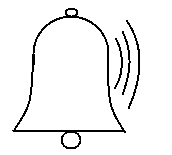
Which of the following correctly show the way sound vibrations travel?
(A)

(B)

(C)

(D)

Answer
216.3k+ views
Hint: Sound vibrations in air are formed when air molecules oscillate or vibrate and move at a direction away from the vibrating source. Sound vibrations travel in any material medium in the form of sound waves which are mechanical in nature.
Complete answer:
Sound waves in any material medium are mechanical waves. Sound waves travel in the form of longitudinal vibrations. Longitudinal vibrations have a distinctive property that they move in all directions. Longitudinal waves travel in any material medium in the form of a series of compressions and rarefactions.
Thus, sound waves travel outwards in all directions in the form of a series of compressions and rarefactions of the particles of the medium from the source. As the longitudinal sound waves travel, the energy they contain becomes dissipated or damped and as a result of which the intensity of the sound becomes weaker the farther it is from the source.
Thus, we can say that the shape of a longitudinal sound wave vibration with no obstacles in its direction of propagation would be spherical under approximation.
Since only the figure given in option (C) properly matches our description of a longitudinal sound wave vibration.
We can say that option (C) is the correct answer to this question.
Note: If we consider a sound wave to be moving at a direction from left to right through a medium of air, then in this condition the particles of the medium of air will be displaced at directions both rightward and leftward as the energy of the sound wave passes through it.
The motion of the particles of the medium is both, parallel and anti-parallel to the direction of the energy transport. This is what characterizes sound waves travelling in any material medium such as air as longitudinal waves.
Complete answer:
Sound waves in any material medium are mechanical waves. Sound waves travel in the form of longitudinal vibrations. Longitudinal vibrations have a distinctive property that they move in all directions. Longitudinal waves travel in any material medium in the form of a series of compressions and rarefactions.
Thus, sound waves travel outwards in all directions in the form of a series of compressions and rarefactions of the particles of the medium from the source. As the longitudinal sound waves travel, the energy they contain becomes dissipated or damped and as a result of which the intensity of the sound becomes weaker the farther it is from the source.
Thus, we can say that the shape of a longitudinal sound wave vibration with no obstacles in its direction of propagation would be spherical under approximation.
Since only the figure given in option (C) properly matches our description of a longitudinal sound wave vibration.
We can say that option (C) is the correct answer to this question.
Note: If we consider a sound wave to be moving at a direction from left to right through a medium of air, then in this condition the particles of the medium of air will be displaced at directions both rightward and leftward as the energy of the sound wave passes through it.
The motion of the particles of the medium is both, parallel and anti-parallel to the direction of the energy transport. This is what characterizes sound waves travelling in any material medium such as air as longitudinal waves.
Recently Updated Pages
JEE Atomic Structure and Chemical Bonding important Concepts and Tips

JEE Amino Acids and Peptides Important Concepts and Tips for Exam Preparation

Electricity and Magnetism Explained: Key Concepts & Applications

Chemical Properties of Hydrogen - Important Concepts for JEE Exam Preparation

JEE Energetics Important Concepts and Tips for Exam Preparation

JEE Isolation, Preparation and Properties of Non-metals Important Concepts and Tips for Exam Preparation

Trending doubts
JEE Main 2026: Application Form Open, Exam Dates, Syllabus, Eligibility & Question Papers

Derivation of Equation of Trajectory Explained for Students

Hybridisation in Chemistry – Concept, Types & Applications

Understanding the Angle of Deviation in a Prism

Understanding Collisions: Types and Examples for Students

How to Convert a Galvanometer into an Ammeter or Voltmeter

Other Pages
JEE Advanced Marks vs Ranks 2025: Understanding Category-wise Qualifying Marks and Previous Year Cut-offs

Units And Measurements Class 11 Physics Chapter 1 CBSE Notes - 2025-26

NCERT Solutions For Class 11 Physics Chapter 8 Mechanical Properties Of Solids

Motion in a Straight Line Class 11 Physics Chapter 2 CBSE Notes - 2025-26

NCERT Solutions for Class 11 Physics Chapter 7 Gravitation 2025-26

Ideal and Non-Ideal Solutions Explained for Class 12 Chemistry




